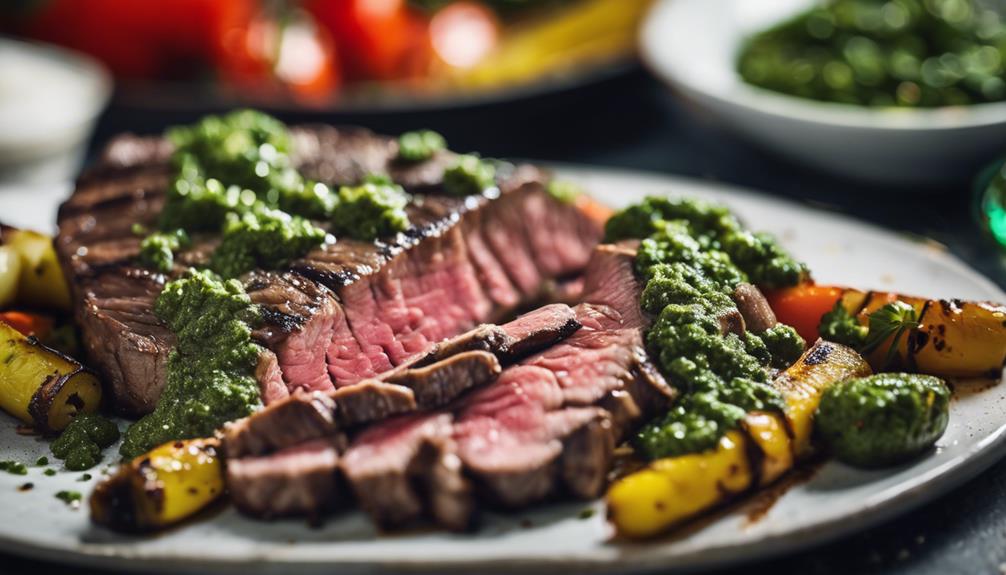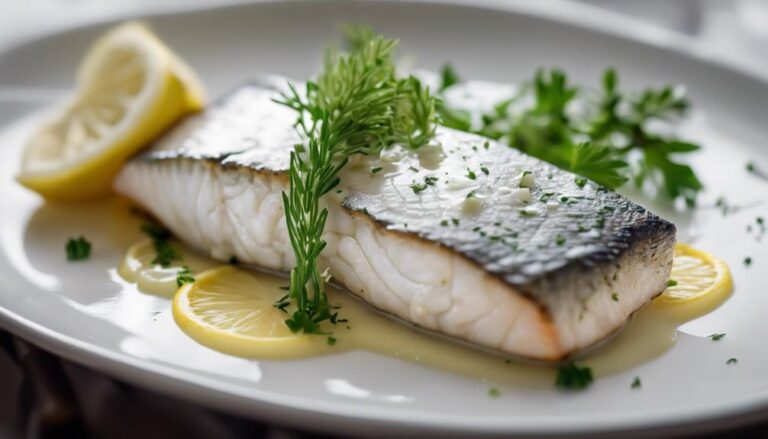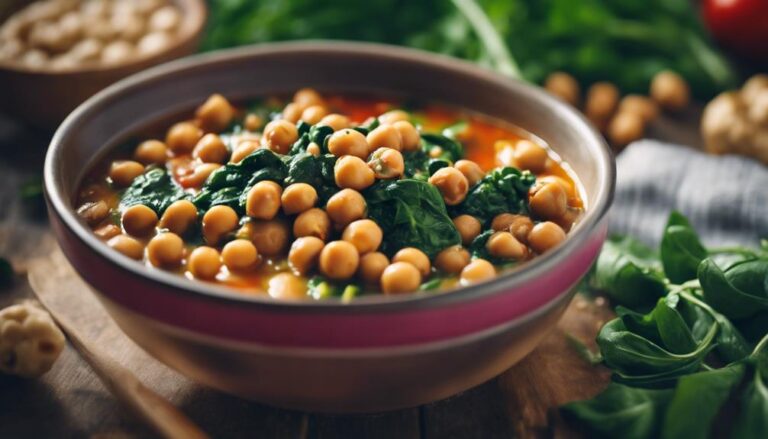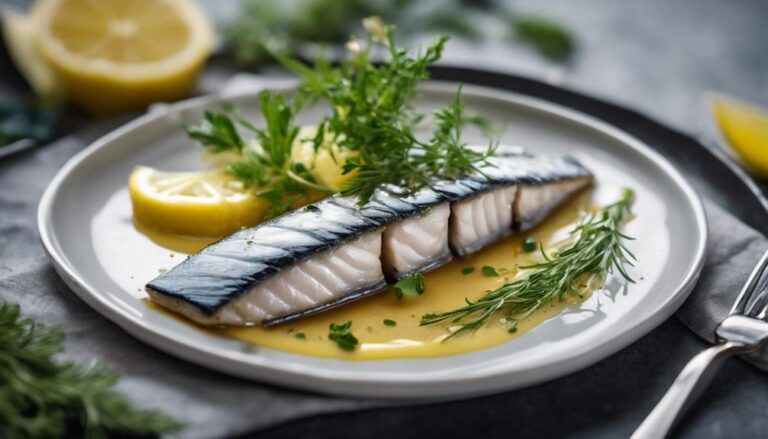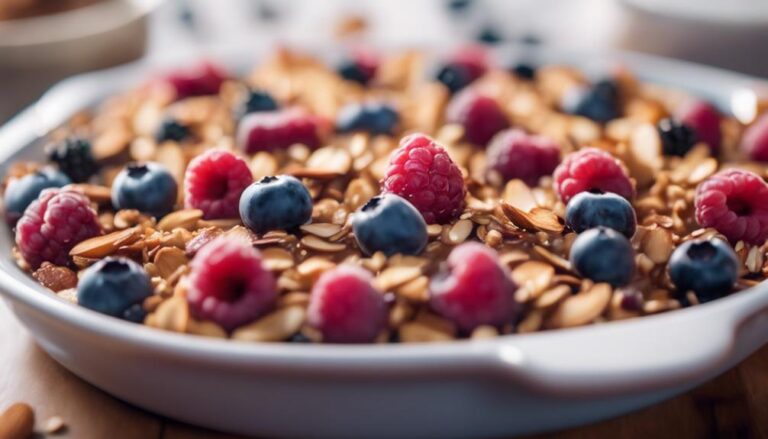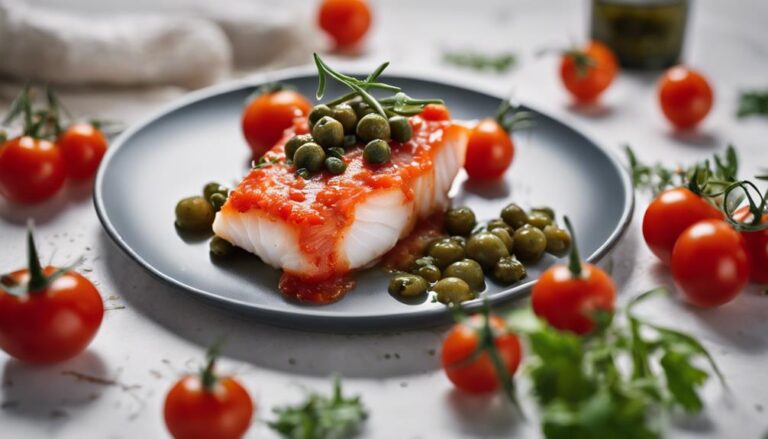Sous Vide Flank Steak With Chimichurri
To make Sous Vide Flank Steak with Chimichurri, season the steak with salt, pepper, and garlic. Vacuum seal it and cook it in a water bath at 130°F for 2 hours. Prepare chimichurri sauce with parsley, garlic, vinegar, oil, and red pepper flakes. Sear the steak for a crusty finish. Slice against the grain and top with chimichurri. Enjoy the tender, flavorful result of this modern cooking method paired with a zesty sauce. The combination of sous vide and chimichurri creates a culinary delight for your taste buds, offering a unique experience worth savoring further.
What You Will Learn Here
- Sous vide cooking ensures optimal tenderness and flavor infusion in flank steak.
- Chimichurri sauce adds a vibrant herb and garlic kick to the dish.
- Marinate flank steak before sous vide for enhanced taste and tenderness.
- Sear the sous vide flank steak for a caramelized crust and added flavor.
- Rest the flank steak before slicing to retain juices and tenderness.
Steak's Evolution Over Time
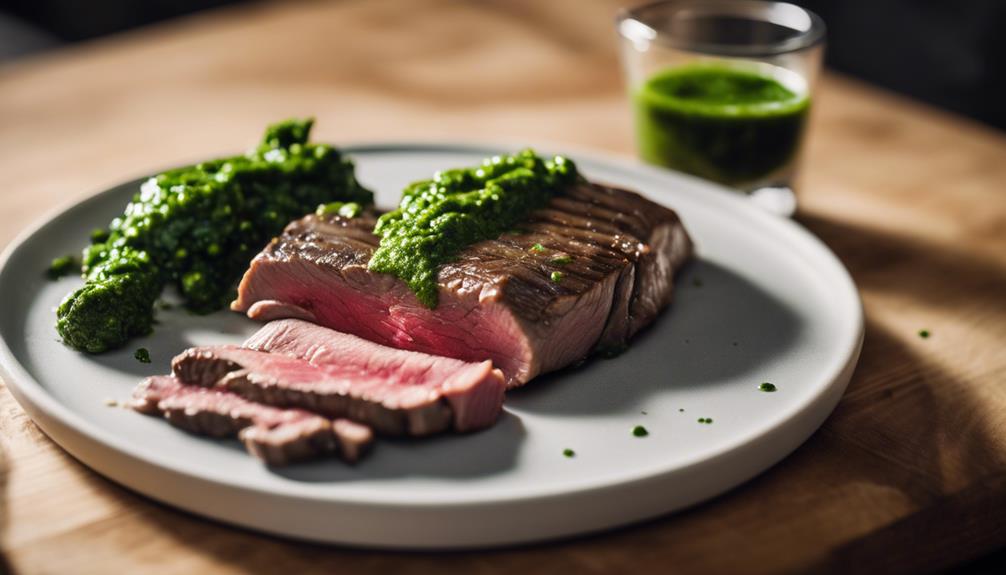
Steak has undergone significant changes throughout history, adapting to different cooking methods and cultural influences. Its evolution traces back to ancient times, where early civilizations developed unique ways to prepare and enjoy this meat.
History of Steak
Through centuries of culinary evolution, meat cuts have transformed from humble beginnings into the succulent steaks we savor today. The origins of steak can be traced back to ancient times when early humans cooked meat over open flames. These primitive cooking techniques evolved over time, leading to the development of more sophisticated methods such as roasting, grilling, and eventually, modern sous vide cooking.
Steak has a rich history that varies across cultures. In ancient Rome, beef was a symbol of wealth and power, often enjoyed by the elite. As societies advanced, steak became a staple food for many, valued for its flavor and tenderness. Over the years, different regions around the world have adopted unique approaches to preparing and seasoning steak, resulting in a diverse range of culinary traditions.
Today, steak is enjoyed globally in various forms, from traditional cuts like ribeye and sirloin to more contemporary creations. The evolution of steak illustrates how culinary practices have continually adapted to meet changing tastes and preferences, ensuring that this beloved dish remains a timeless favorite.
Cooking Methods Timeline
Over the centuries, culinary techniques for preparing meat have evolved greatly, leading to diverse methods for cooking steak. In the timeline of steak's evolution, cooking techniques and innovation have played a pivotal role. Early on, meat preparation was rudimentary, relying on open flames and basic tools. As technology advanced, so did the methods for cooking steak.
In ancient times, grilling over an open flame was the primary method. However, with the advent of pottery and metal cookware, techniques like pan-searing and roasting became popular. The Industrial Revolution brought about significant changes, introducing mass production and distribution of meat, which influenced cooking practices.
The 20th century saw the rise of new technologies like sous vide cooking, revolutionizing steak preparation. Sous vide involves vacuum-sealing meat and cooking it in a precisely controlled water bath. This method guarantees consistent results and has gained popularity for its ability to retain the meat's juices and flavors. Today, steak lovers have a plethora of cooking techniques at their disposal, showcasing the continuous innovation in meat cooking technology.
Cultural Influences on Steak
Throughout history, various cultures have greatly influenced the evolution of meat preparation techniques, shaping the way we cook and enjoy steak today.
Cultural influences on steak have led to a diverse range of flavors and cooking methods. For example, in Argentina, the tradition of grilling steak over an open flame has given rise to the famous chimichurri sauce, a zesty blend of parsley, garlic, and vinegar that complements the rich flavors of the meat.
In contrast, Asian cultures often incorporate steak into stir-fries or marinate it in soy sauce and spices for a fusion of flavors. These regional variations reflect the unique culinary traditions and preferences of each culture, showcasing the adaptability of steak as an ingredient.
As people around the world continue to experiment with different cultural influences, steak remains a versatile and beloved dish that continues to evolve with the changing tastes and preferences of society.
Steak Marinade Components
For a flavorful marinade, combine fresh herbs, garlic, citrus juice, and olive oil to enhance the taste of your flank steak. When preparing your marinade, consider the following components:
- Fresh Herbs: Herbs like parsley, cilantro, or oregano add a burst of freshness to your marinade, infusing the steak with vibrant flavors.
- Garlic: Crushed or minced garlic brings a pungent aroma and sharp taste, complementing the richness of the steak.
- Citrus Juice: Whether it's lemon, lime, or orange juice, the acidity tenderizes the meat while providing a tangy brightness to each bite.
Marinating your steak with this combination of ingredients not only adds depth to the flavor but also helps to tenderize the meat for a juicy and succulent outcome. Experiment with the ratios of these components to find the perfect balance that suits your taste preferences.
Trending Steak Preparations
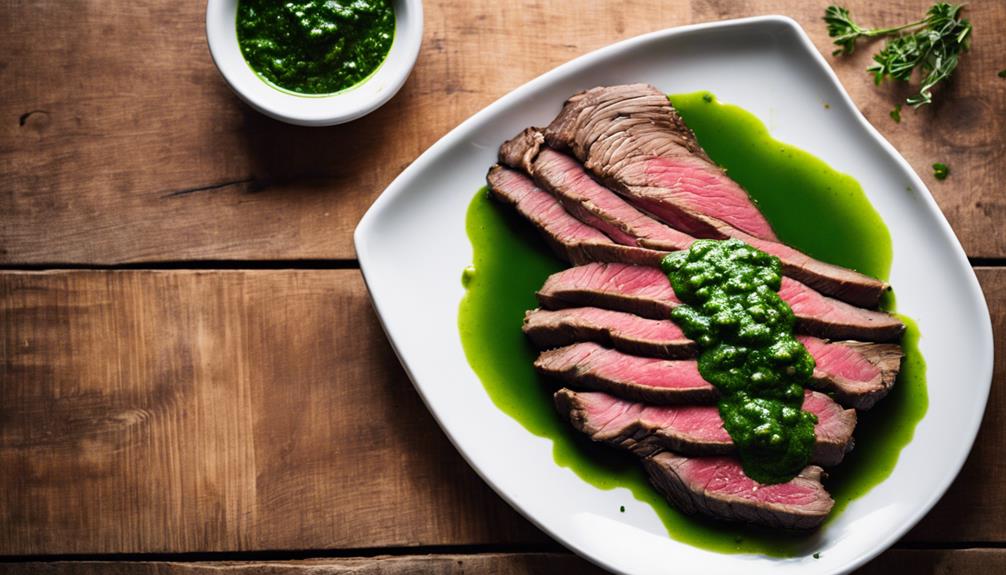
Let's talk about some popular ways to prepare steak that are currently trending.
You might want to explore dishes like Chimichurri Sous Vide Flank, Sous Vide Ribeye Steak, and Sous Vide Filet Mignon.
These methods offer a unique twist on traditional steak preparation, promising tender and flavorful results that are sure to impress your taste buds.
Whether you're a seasoned chef or just starting in the kitchen, experimenting with these trending steak preparations can take your culinary skills to the next level.
Chimichurri Sous Vide Flank
When preparing Chimichurri Sous Vide Flank, consider marinating the steak overnight for maximum flavor infusion. This technique allows the flavors of the chimichurri marinade to penetrate the flank steak thoroughly, resulting in a tender and flavorful dish.
Here are some tips to enhance your Chimichurri Sous Vide Flank experience:
- Sous Vide Techniques: Utilize sous vide cooking to achieve a perfectly cooked flank steak. By vacuum-sealing the marinated steak and cooking it in a water bath at a precise temperature, you can guarantee a consistent and juicy result.
- Flavor Profile: The combination of fresh herbs, garlic, vinegar, and olive oil in chimichurri provides a bright and tangy flavor that complements the richness of the flank steak. Adjust the ingredients to suit your taste preferences.
- Chimichurri Variations: Experiment with different chimichurri variations, such as adding a touch of spice with red pepper flakes or incorporating citrus zest for a revitalizing twist. Serve the Chimichurri Sous Vide Flank sliced thinly against the grain and drizzle extra chimichurri sauce on top for an extra burst of flavor.
Sous Vide Ribeye Steak
To elevate your culinary skills and delight your taste buds, consider exploring the delectable world of Sous Vide Ribeye Steak, a trending preparation method that promises juicy and tender results. When cooking Sous Vide Ribeye Steak, follow these essential steps to achieve perfection:
- Seasoning: Before vacuum-sealing the ribeye steak for sous vide cooking, generously season it with your favorite herbs and spices to enhance the flavors.
- Temperature Control: Set your sous vide immersion circulator to the desired temperature for the level of doneness you prefer. This precise control guarantees the steak cooks evenly from edge to edge.
- Searing: After the sous vide process, pat the steak dry and sear it in a hot pan or on a grill for a delicious crust that adds texture and depth of flavor.
Sous Vide Filet Mignon
Pivot from the sous vide ribeye steak to the sous vide filet mignon by exploring a leaner cut that promises exquisite tenderness and flavor.
When preparing sous vide filet mignon, consider these tips:
- Sous Vide Techniques: Sous vide is a precise method for cooking filet mignon to perfection. Seal the seasoned filet in a bag, removing air to guarantee even cooking. Set your sous vide machine to the desired temperature, typically around 130°F for a medium-rare finish. Cook the filet for 1-2 hours for a melt-in-your-mouth texture.
- Food Safety: Ensure the filet mignon reaches a safe internal temperature. After sous vide cooking, sear the filet on high heat for a beautiful crust while maintaining the juicy center.
- Flavor Profiles: Filet mignon's mild flavor pairs well with simple seasonings like salt, pepper, and herbs. Experiment with different seasoning preferences to enhance the natural taste of the meat.
Searing for Flavor
When it comes to searing your flank steak, remember that searing enhances the flavor by creating a caramelized crust through the Maillard reaction. This reaction is essential as it adds depth and complexity to the taste of your steak.
Additionally, searing impacts not only the flavor but also the texture and appearance of the final dish.
Enhancing Flavor Through Searing
For a bolder flavor profile, consider searing your sous vide flank steak before serving. Searing techniques can elevate the taste of your steak by creating a delicious crust on the outside while keeping the inside tender and juicy. To achieve this, pat your steak dry with a paper towel before searing to guarantee a good sear. Heat a cast-iron skillet over high heat and add a high smoke point oil like canola or grapeseed oil. Carefully place your steak in the hot skillet and sear each side for about a minute until a golden brown crust forms.
When it comes to seasoning options, a simple mix of salt, pepper, and garlic powder can enhance the natural flavors of the meat. You can also experiment with different spice blends like cumin, paprika, or chili powder for a unique twist. For presentation tips, let your steak rest for a few minutes after searing to lock in the juices before slicing it against the grain for a tender bite. Searing not only adds flavor but also creates an appealing visual contrast between the crispy exterior and the perfectly cooked interior of your sous vide flank steak.
Maillard Reaction Importance
To fully understand the impact of the Maillard reaction on your sous vide flank steak's flavor, consider how searing creates a transformative crust that enhances the overall taste experience.
The Maillard reaction is an essential browning process that occurs when proteins and sugars on the steak's surface caramelize, leading to the development of complex flavors. This reaction not only adds depth to the taste profile but also creates a visually appealing crust that contrasts with the tender interior of the meat.
Through surface caramelization, the searing process enhances the umami notes and intensifies the savory richness of the flank steak, contributing to a more flavorful dining experience.
The Maillard reaction's role in taste enhancement can't be overstated; it elevates the overall enjoyment of the dish by providing a delicious contrast between the crispy exterior and the succulent interior of the steak.
Searing your sous vide flank steak effectively harnesses the Maillard reaction to create a flavorful and visually striking culinary masterpiece.
Texture and Appearance Impact
Achieving the desired texture and appearance of your sous vide flank steak can be greatly enhanced through the process of searing, which adds a flavorful crust to the meat. Searing the steak after sous vide not only creates a beautiful visual appeal with its golden-brown exterior but also contributes to texture contrast, providing a delightful crunch that complements the tender, juicy interior. This texture contrast elevates the overall mouthfeel experience, making each bite a sensory delight.
When it comes to presentation aesthetics, the sear marks left on the steak add an element of sophistication to your dish, making it visually appealing and appetizing. The caramelization from searing enhances the flavors and creates a more complex taste profile that's sure to impress your guests. Additionally, the Maillard reaction that occurs during searing not only enhances the aroma but also deepens the overall flavor of the flank steak. So, for a dish that excites both the eyes and the taste buds, searing your sous vide flank steak is a vital step in achieving culinary perfection.
Final Thoughts
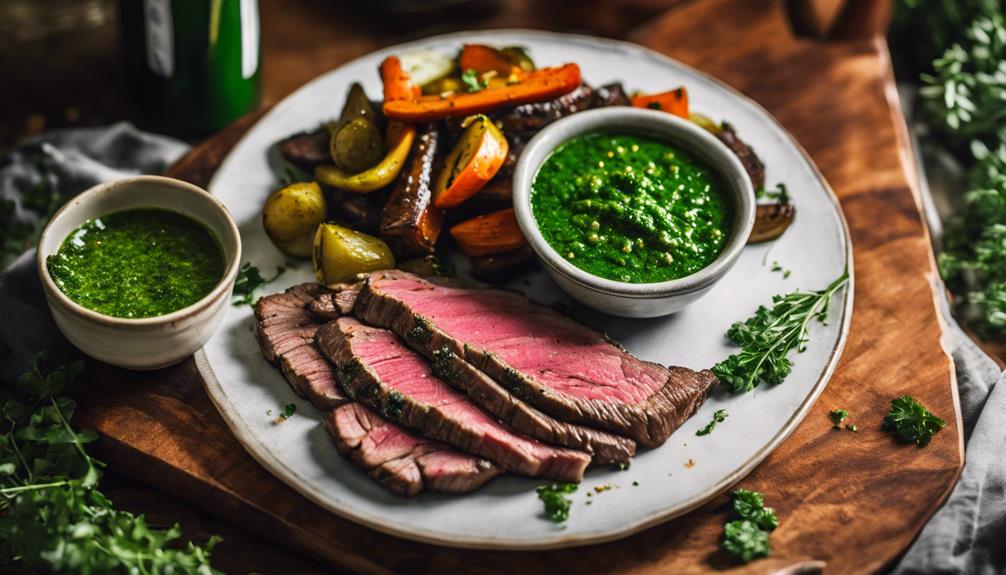
In conclusion, consider experimenting with different cuts of meat and variations of chimichurri to elevate your sous vide cooking experience. Reflections on your culinary journey can lead to new inspirations and innovations in the kitchen. As you explore the world of sous vide cooking, remember that each cut of meat offers unique textures and flavors when cooked using this method. Take the time to savor the process and pay attention to how different ingredients interact with each other to create a harmonious dish.
Culinary inspiration can strike at any moment, so don't be afraid to think outside the box and try new combinations. Whether you prefer a traditional chimichurri with parsley and garlic or want to experiment with adding a twist like a hint of citrus or a touch of spice, the possibilities are endless. By infusing your own creativity into the recipes you try, you can truly make them your own and delight your taste buds with exciting flavors. Enjoy the journey of discovery in the kitchen as you continue to hone your sous vide skills and expand your culinary horizons.
Frequently Asked Questions
Can I Use a Different Cut of Meat for This Recipe?
Yes, you can use different meat alternatives for this recipe. While flank steak is commonly used, other cuts like skirt steak or sirloin can work well too. Experiment with various cooking techniques like sous vide for best results.
How Long Should I Let the Steak Rest Before Slicing?
Let the steak rest for about 10-15 minutes before slicing. This short resting period allows the juices to redistribute, enhancing flavor and preserving juiciness. Slicing too soon can result in a loss of those delicious juices.
Can I Make the Chimichurri Sauce in Advance?
Yes, you can make chimichurri sauce in advance for enhanced flavor. Store it in an airtight container in the fridge for up to a week. Consider experimenting with ingredient substitutions for unique variations. Enjoy the convenience of prepping ahead.
Is It Necessary to Use a Vacuum Sealer for Sous Vide Cooking?
You don't need a vacuum sealer for sous vide. While it offers benefits like airtight seals, you can use alternative methods like water displacement. Ziplock bags work too. Just make sure to get a good seal.
Can I Use a Regular Skillet Instead of a Cast-Iron Pan for Searing?
You can use a regular skillet for searing instead of a cast-iron pan. Just make sure that it is heavy-bottomed and preheated adequately. Experiment with different oils for varied flavors. Practice proper searing techniques to achieve a flavorful crust.
Conclusion
To sum up, sous vide flank steak with chimichurri offers a modern twist on a classic dish, enhancing the flavors and tenderness of the meat.
By marinating the steak and cooking it sous vide style, you can achieve a perfectly cooked and flavorful steak every time.
Searing the steak at the end adds a delicious charred crust, completing the dish with a satisfying texture.
Give this trendy preparation a try for a delicious and impressive meal.
